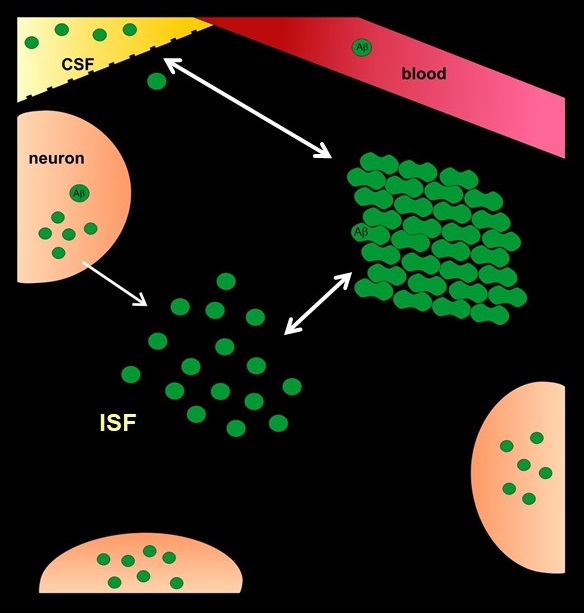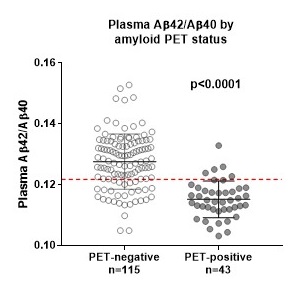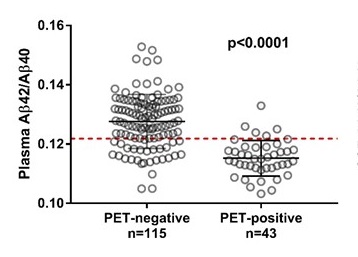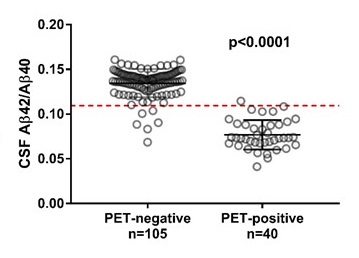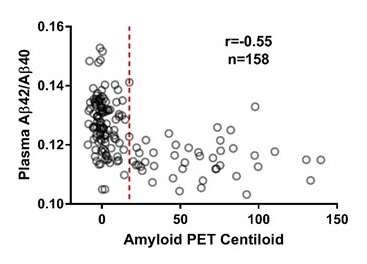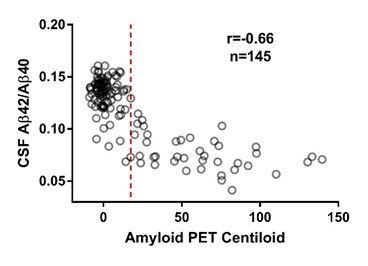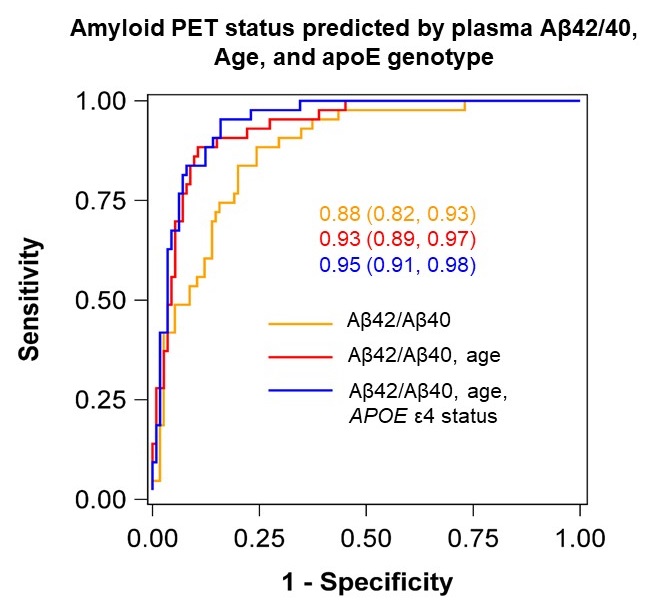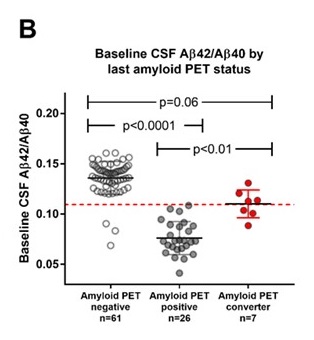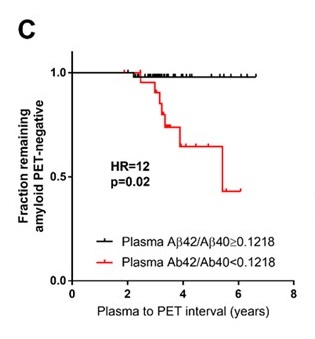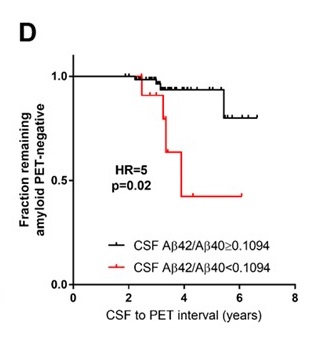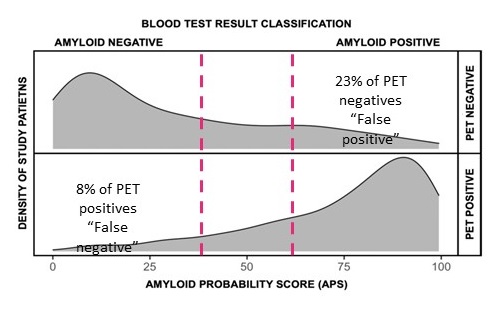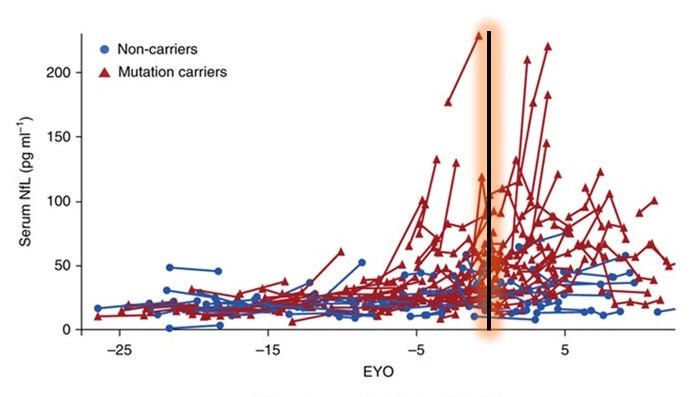Monday, January 25, 2021
Printer Friendly Version in PDF Format (14 PDF pages)
Update on blood based biomarkers for Alzheimer's Disease
David M. Holtzman, MD
Professor and Chair of Neurology
Washington University in St. Louis
Disclosures
- Co-founder, C2N Diagnostics LLC.
- Scientific advisory boards/consulting: Genentech, C2N Diagnostics, Denali, Merck, Cajal Neurosciences, Annexon
- David Holtzman is an inventor on a patents licensed by Washington University to 1) C2N Diagnostics on the therapeutic use of anti-tau antibodies. This anti-tau antibody program is licensed to Abbvie and 2) Eli Lilly on the therapeutic use of an anti-amyloid-β antibody; 3) materials and methods related to assessing Aβ and tau in plasma blood tests.
- The Holtzman lab receives research grants from the National Institutes of Health, Cure Alzheimer's Fund, Tau Consortium, the JPB Foundation, Good Ventures, Bright Focus, and C2N Diagnostics.
Model of Alzheimer's brain pathology
 |
| Holtzman DM, Morris JC, Goate AM (2011) Science Translational Medicine Vol 3, Issue 77 |
AD pathological changes in relation to clinical manifestations
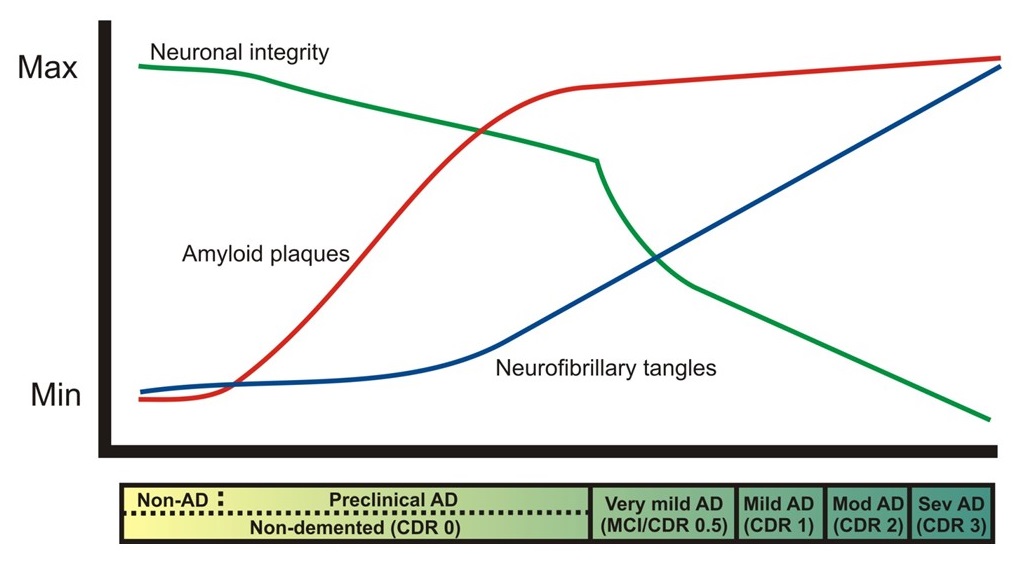 |
| Perrin, Fagan, and Holtzman, Nature. 2009, 461:916-922 |
Alzheimer's Disease-Related Dementias Summit 2016
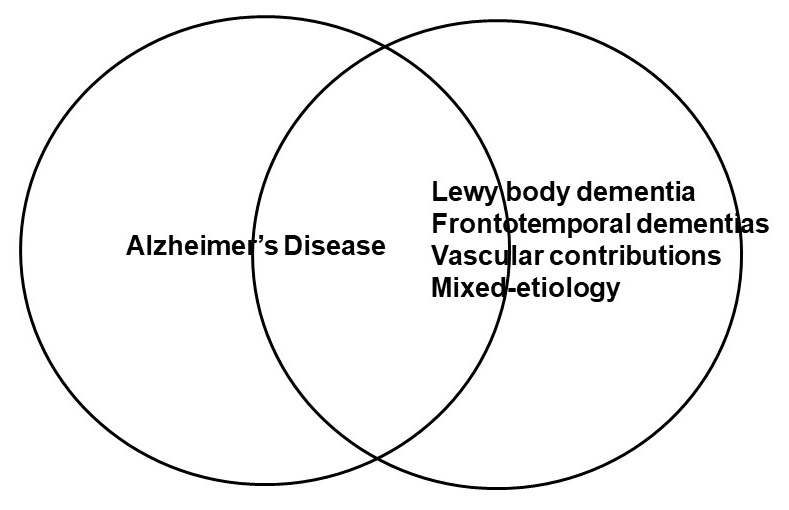 |
| Alzheimer's disease causes or contributes to ~70% of dementia. A variety of other disorders cause the other 30%. The most common contributors are vascular contributions (stroke), Lewy body dementia, and frontotemporal dementia. A fairly large percentage of people with AD also have these other disorders, especially vascular related. |
What is a biomarker?
- World Health Organization:
- Almost any measurement reflecting an interaction between a biological system and a potential hazard, which may be chemical, physical, or biological. The measured response may be functional and physiological, biochemical at the cellular level, or a molecular interaction.
- Examples in medicine of biomarkers include: pulse, blood pressure, LDL and HDL cholesterol
- In the case of Alzheimer's disease (AD), the biomarkers to be discussed today are those that objectively mark aspects of AD pathology in the brain: amyloid plaques, neuronal response to amyloid, tau tangles, and neurodegeneration (brain injury/cell death).
How are AD biomarkers used?
- Research- to understand underlying causes of AD pathophysiology
- Clinical trials
- Treatment trials- To confirm that AD is the likely cause of cognitive impairment
- Prevention trials- To identify cognitively normal participants with AD brain pathology
- Target engagement- To confirm that drugs are affecting AD-related targets
- Clinic
- Currently, to evaluate for AD brain pathology in patients where the clinician suspects AD as the cause of cognitive symptoms but is uncertain
- In the future, when we have disease-modifying therapies (e.g. pills, antibody injections, other interventions), a test confirming underlying AD pathology will be likely be required to start treatment
Limitations to imaging- and CSF-based AD tests
- Amyloid PET:
- Expensive (~$5,000/scan) and not covered by insurance
- Limited availability (only major medical centers)
- Small amount of radiation
- CSF biomarkers:
- Lumbar puncture may be perceived as invasive
- Small but real risks of headache or back soreness
- Somewhat expensive (~$750 or more just for Aβ42, Aβ40, tau, ptau181, depending on company); requires time from physician/staff that may not be adequately compensated
- Not convenient
Advantages of a blood test
- Practical advantages
- Individuals are comfortable having blood drawn
- Blood can be drawn almost anywhere and samples can be shipped to a lab for testing
- Lower costs may be possible (e.g. <$1,300)
- Scientific advantages
- Multiple proteins can be measured with a single blood sample
- Results are a number, rather than a more subjective "read," facilitating interpretation of results
- Studies could measure AD biomarkers without burden of imaging/lumbar puncture
- Potential impact on clinical trials and the clinic
- Participants in clinical trials could be screened/recruited more rapidly and cost-effectively, speeding development of effective treatments
- Currently, <~5% of dementia patients are evaluated with AD biomarkers--if an accurate blood test is developed, this could increase to ~80%
- More widespread use of blood-based biomarkers could potentially lead to earlier and more accurate diagnosis of AD dementia
Cerebral binding of the amyloid-binding molecule, [11C]PIB, is a biomarker of amyloid plaques, detected by a PET scan
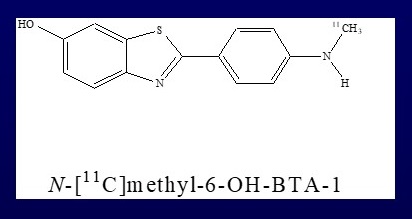 |
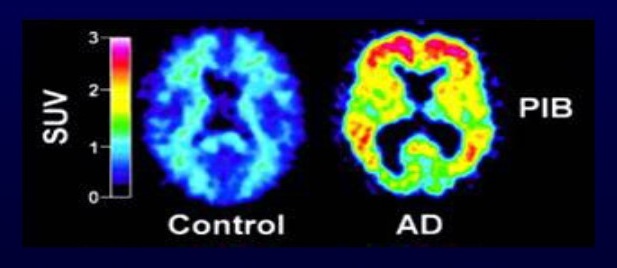 |
| [11C]PIB: benzothiazole analog, Pittsburgh Compound B, tagged for PET |
(adapted from Klunk et al., 2004, Ann. Neurol.55:306-19) |
CSF Aβ42 is in equilibrium with plaques
Normal and demented subjects with amyloid in the brain have a low CSF Aβ42 (N=209)
 |
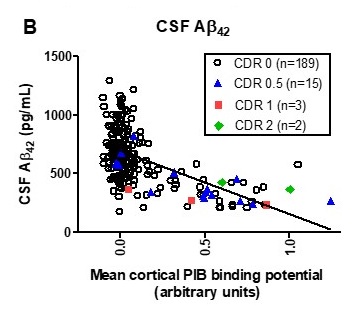 |
 |
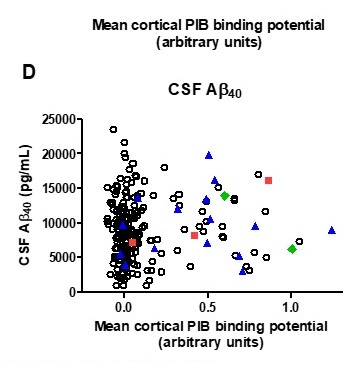 |
| Fagan AM et al. 2009 EMBO Mol. Med, 1:371-380 |
Plasma Aβ42/Aβ40 = amyloid PET?
- Normalizing Aβ42 to Aβ40 likely accounts for some pre-analytical variation and individual differences in Aβ production and diurnal variation; Aβ42/Aβ40 is a measure of Aβ42 sequestration into plaques just like in CSF.
- The difference between abnormal and normal is small (~10%), so a precise assay is required
- Multiple groups have reported that high precision assays for Aβ42/Aβ40 using mass spec are highly concordant with amyloid PET1-4, especially after consideration of APOE ε4 genotype3,4
- "False positive" plasma Aβ42/Aβ40 results predict conversion to amyloid PET positive; plasma may be positive before amyloid PET4
- Ovod A&D 2017
- Nakamura Nature 2018
- Verberk Ann Neurol 2018
- Schindler S... Bateman R. Neurology 2019
Plasma and CSF Aβ42/40 identifies is useful in identifying those who are have amyloid in brain as see via PET scan
Plasma Aβ42/40 highly specific for gold-standard measures of amyloid PET and can perform as well as CSF or PET compared to pathologic confirmation (AUC ~0.9) with age and ApoE status
Baseline plasma and CSF Aβ42/Aβ40 predict amyloid PET status conversion.
Individuals who were amyloid PET-negative at baseline and converted to amyloid PET-positive over the follow-up period had lower baseline plasma Aβ42/Aβ40 than individuals who remained amyloid PET-negative
The first blood test for detection of amyloidosis in individuals with cognitive impairment is now available for clinical use
- PrecivityAD test from C2N Diagnostics (IPMS plasma Aβ42/Aβ40 + APOE genotype + age)
- More AD blood tests will likely follow soon (e.g. pTau181, pTau217, NfL)
Brain amyloid significantly correlates with CSF tau and tau/Aβ42 ratio in individuals who are cognitively normal (N=189)
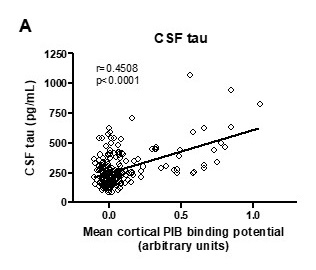 |
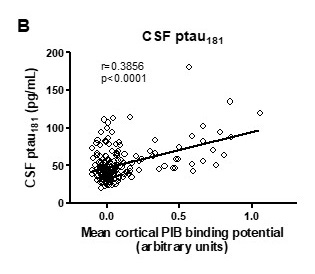 |
 |
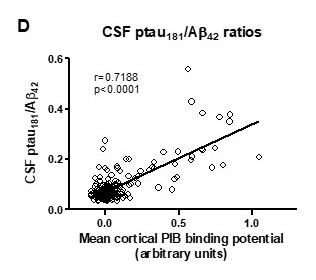 |
| Fagan AM et al. 2009 EMBO Mol. Med, 1:371-380 |
Time course of clinical and biomarker changes in dominantly inherited Alzheimer's disease in relation to expected parental age of dementia onset
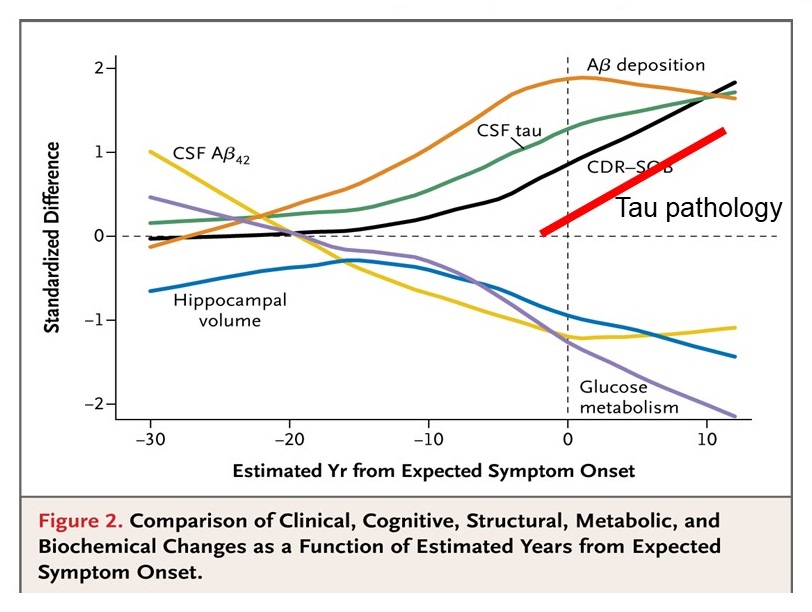 |
| Bateman R et al. from the DIAN Network 2012 NEJM 30;367(9):795-804 |
CSF tau and Aβ42 predict progression from cognitively normal to very mild dementia/MCI and MCI to AD
 |
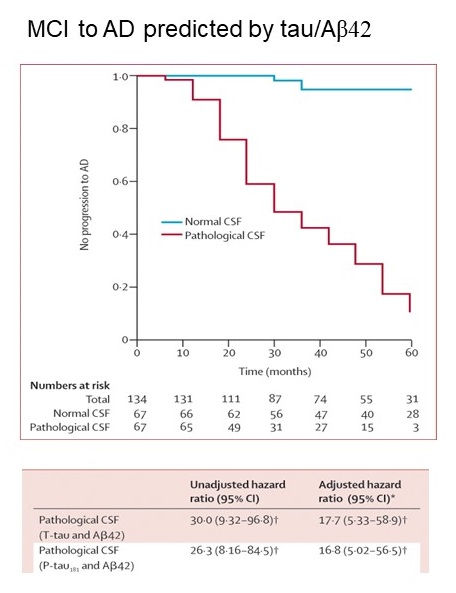 |
| Vos SJ et al. 2013 Lancet Neurology 12:957-65; Craig-Schapiro R, et al. 2010 Biol. Psychiatry 2010 68:903-12; Tarawneh et al., 2011 Ann Neurol 70:274-85; Fagan et al., 2007 Arch Neuro, 64:343-349; Li et al., 2007, Neurology, 69:631. |
Hansson et al. 2006 Lancet Neurol. 5:228-234 |
pTau isoforms may be helpful in staging AD
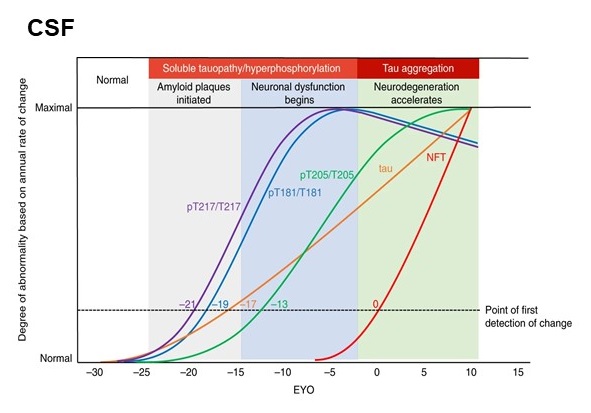 |
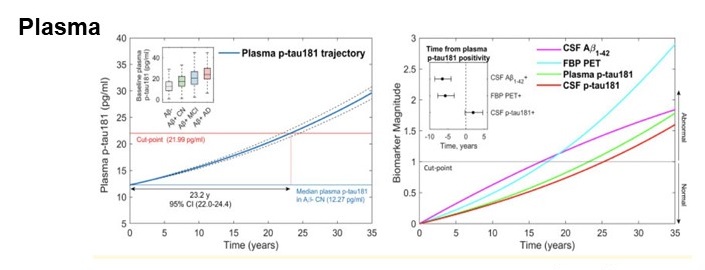 |
| Barthelemy, et al. Nature Med 2020 |
Moscoso et al. Brain 2020 |
| |
 |
| Mattsson-Carlgren et al. Brain 2020 |
Plasma pTau--better correspondence with symptoms
- Plasma pTau1811-7 and pTau2175,6,8
- Good concordance with both amyloid PET and tau PET but these ARE NOT markers of tau tangles -- they are markers of amyloid induced effects on neurons
- Can help differentiate Alzheimer disease from other neurological disorders
- Predicts cognitive decline (pTau181)
- Increases in later stages of the disease
- Mielke A&D 2018
- Janelidze Nat Med 2020
- Thijssen Nat Med 2020
- Karikari Lancet Neurol 2020
- Barthelemy J Exp Med 2020
- Palmqvist JAMA 2020
- Moscoso Brain 2020
- Mattsson-Carlgren Brain 2020
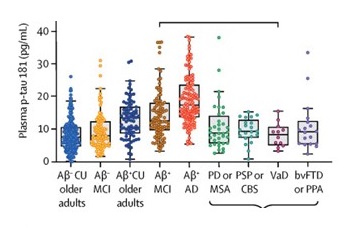 |
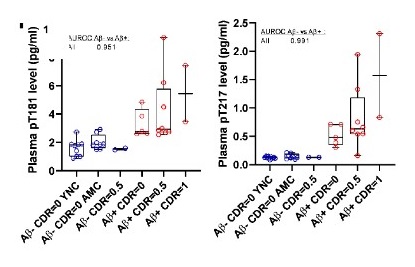 |
| Karikari Lancet Neurol 2020 |
Barthelemy J Exp Med 2020 |
Plasma pTau -- increases over time predicts brain atrophy but only in amyloid positive individuals
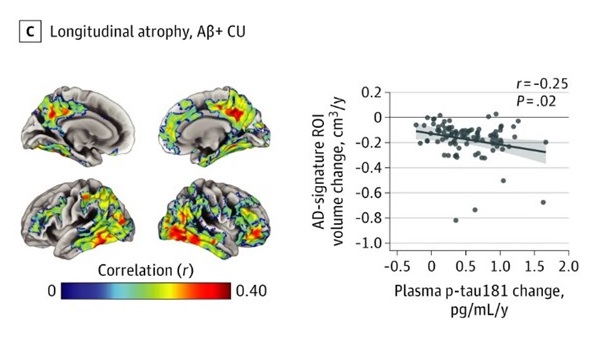 |
 |
| Moscoso A et al. JAMA Neurology 2021: doi:10.1001/jamaneurol.2020.4986 |
Plasma/serum NfL--non-specific neuroaxonal damage
- Plasma NfL is correlated with dementia and brain atrophy1
- Serum NfL increases fastest in individuals who are transitioning from cognitively normal to symptomatic2
- Faster increases in plasma NfL predict smaller brain volume and worse cognitive performance3
- Mattsson JAMA Neurol 2017
- Preische Nat Med 2019
- Mattson JAMA Neurol 2019
Promising blood analytes
- Aβ42/Aβ40
- Becomes positive very early
- Identified brain amyloidosis
- Phosphorylated tau isoforms (including tau phosphorylated at T181, T217)
- Increases during preclinical AD
- Increases with increasing brain amyloidosis
- Neurofilament light protein (NfL)
- Not-specific for specific disease
- But, tells one that there is ongoing neuronal damage
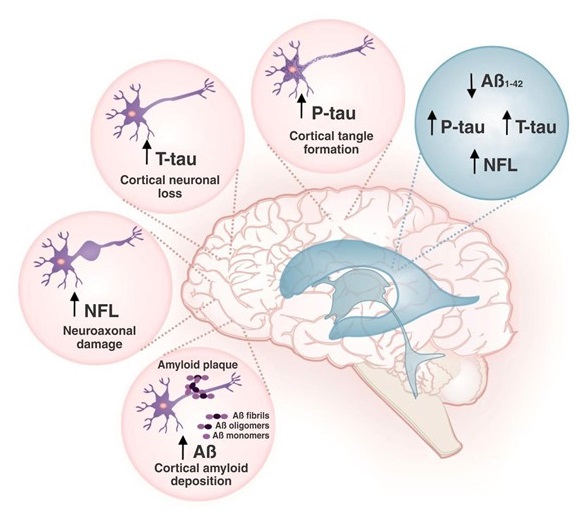 |
| Radanovic BrJPsy 2019 |
Using plasma biomarkers in combination
- Future AD blood tests are likely to use a combination of biomarkers, rather than a single analyte, to predict risk for AD dementia
- Models including individual factors (age, sex, APOE genotype, race, etc., rather than a single cut-off value for positive/negative, are likely to be more accurate)
 |
| Cullen Nature Aging 2020 |
Overall conclusions
- Blood-based biomarkers provide similar information as amyloid PET and CSF biomarkers, but because of practical advantages, may enable broader use of AD biomarker testing
- When measured with a precise assay, plasma Aβ42/Aβ40 is highly concordant with amyloid PET status, especially after consideration of APOE ε4 status
- Plasma pTau isoforms are highly concordant with both amyloid PET status and symptomatic status and could potentially allow for staging of AD
- Widespread use of blood-based biomarkers in clinical diagnosis should lead to earlier and more accurate diagnosis of cognitive impairment due to AD. This will be helpful for clinical trials and hopefully identify those for specific treatment.
- In addition, blood-based biomarkers can identify those with preclinical AD that can targeted for prevention/prevention trials.
Thanks to Randall Bateman and Suzanne Schindler at Washington University!





